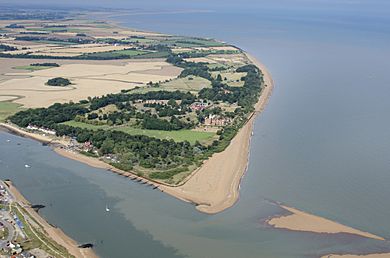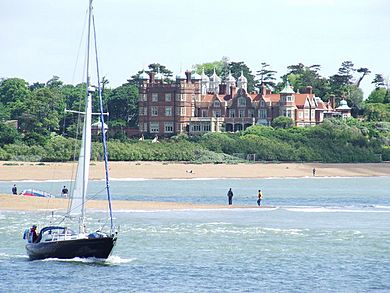Bawdsey Manor facts for kids
Bawdsey Manor is a historic building located right by the River Deben in Suffolk, England. It's about 120 kilometers (75 miles) northeast of London.
This grand manor was built in 1886 and made even bigger in 1895. It was the main home of Sir William Cuthbert Quilter, an important person at the time. During World War I, soldiers from the Devonshire Regiment used the manor.
After the war, the Quilter family got it back. But in 1936, the Air Ministry bought it for £24,000. They turned it into a secret research station to develop the Chain Home RDF (which stands for Radio Direction Finding, now known as radar) system. This became RAF Bawdsey. It stayed a military base through the Cold War until the 1990s.
Today, PGL uses Bawdsey Manor for fun courses and holidays for children and young people. There's also a small museum inside the old radar transmitter building where you can learn about its amazing history.
Contents
Bawdsey Manor's Early Days: 1886-1936
Bawdsey Manor was first built in 1886. It was made larger in 1895 by William Quilter. He was a big art collector and helped start the National Telephone Company. He was also a Member of Parliament for Sudbury.
In 1894, William Quilter created a steam-powered ferry. This ferry crossed the River Deben to help people get to the nearest train station in Felixstowe. It was called the Bawdsey Ferry and ran until 1931. Today, a motor-launch ferry still operates on weekends during the summer.
Maude Marion Quilter, Sir William's daughter, lived at Bawdsey Manor. She later hired Harry Thrower, the father of famous gardener Percy Thrower, as a gardener for her other home. Harry had started his gardening career right here at Bawdsey Manor.
RAF Bawdsey: A Secret Radar Base (1936-1990)
In February 1936, important scientists, including Robert Watson-Watt, moved into Bawdsey Manor. They started working on radar for military use, and the site became known as RAF Bawdsey. The old stables and other buildings were turned into workshops. They also built tall wooden receiver towers (73 meters or 240 feet high) and even taller steel transmitter towers (110 meters or 360 feet high).
Bawdsey was the Air Ministry's secret radar research center. It was where many key radar scientists and the first RAF and WAAF (Women's Auxiliary Air Force) radar staff were trained. From 1937, Bawdsey was the first operational station of the Chain Home radar system. During World War II, it also used other radar systems to track enemy ships.
The base continued as a radar station through most of the Cold War. The tall towers were taken down starting in the 1960s, and none of them remain today. Bloodhound surface-to-air missiles were placed on the cliffs until 1990. RAF Bawdsey officially closed in 1991.
Bawdsey Manor Today: After 1990
From 1994 to 2016, the Manor and its grounds were home to Alexanders College. This was a boarding and day school for students aged 11 to 18.
The old Transmitter Block is now a museum. It's called "The Magic Ear" and is run by the Bawdsey Radar Group. It was even featured on the BBC show Restoration.
In 2017, PGL Travel Ltd. bought the property. They opened it for summer programs that same year.
See also
- Bawdsey Ferry
- RAF Bawdsey




